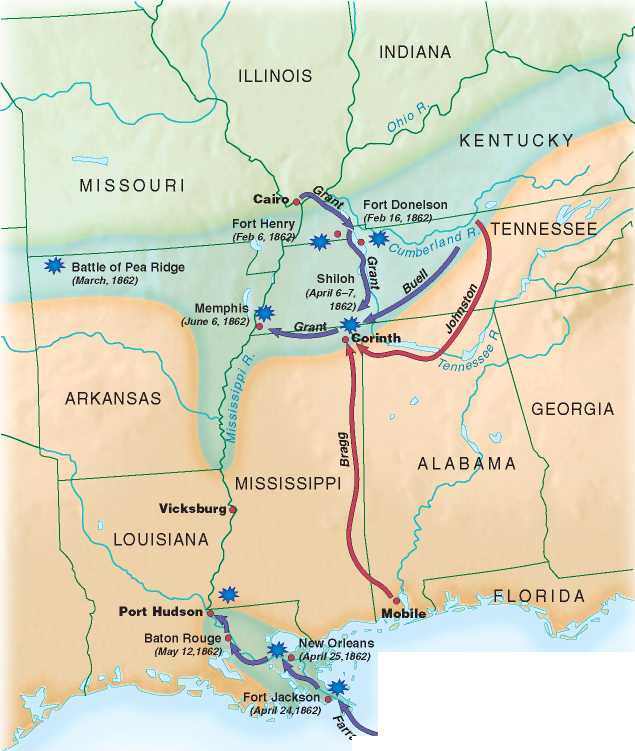After Bull Run no battles were fought until early 1862. Then, while McClellan continued his deliberate preparations to attack Richmond, important fighting occurred far to the west. Most of the Plains Indians sided with the Confederacy, principally because of their resentment of the federal government’s policies toward them. White settlers from Colorado to California were mostly Unionists. In March 1862 a Texas army advancing beyond Santa Fe clashed with a Union force in the Battle of Glorieta Pass. The battle was indecisive, but a Union unit destroyed the Texans’ supply train. The Texans felt compelled to retreat to the Rio Grande, thus ending the Confederate threat to the Far West.
Meanwhile, far larger Union forces, led by a shabby, cigar-smoking West Pointer named Ulysses S. Grant, had invaded Tennessee from a base at Cairo, Illinois. Making effective use of armored gunboats, Grant captured Fort Henry and Fort Donelson, strongholds on the Tennessee and Cumberland rivers, taking 14,000 prisoners. Next he marched toward Corinth, Mississippi, an important railroad junction.
To check Grant’s advance, the Confederates massed 40,000 men under Albert Sidney Johnston. On April 6, while Grant slowly concentrated his forces, Johnston struck suddenly at Shiloh, twenty miles north of Corinth. Some Union soldiers were caught half-dressed, others in the midst of brewing their morning coffee. A few died in their blankets. “We were more than surprised,” one Illinois officer later admitted. “We were astonished.” However, Grant’s men stood their ground. At the end of a day of ghastly carnage the Confederates held the advantage, but fresh Union troops poured in during the night, and on the second day of battle the tide turned. The Confederates fell back toward Corinth, exhausted and demoralized.
Grant, shaken by the unexpected attack and appalled by his losses, allowed the enemy to escape. This cost him the fine reputation he had won in capturing Fort Henry and Fort Donelson. He was relieved of his command. Although Corinth eventually fell and

Gulf of Mexico
Area controlled by Union I I Area seized by Union I I Area controlled by Confederacy Union advance Confederate advance Union victory
(May 12,1862) Date of victory
Battles in the West The Anaconda Plan called for the North to gain control of the Mississippi River. To that end, in the spring of 1862 Grant seized western Kentucky and Tennessee and won a major battle at Shiloh, just north of Corinth. Farragut, attacking by sea from the Gulf of Mexico, moved up the mouth of the Mississippi, seizing New Orleans and Baton Rouge. But the South retained Vicksburg: The Confederacy had not been sliced in two.
New Orleans was captured by a naval force under the command of Captain David Farragut, Vicksburg, key to control of the Mississippi, remained firmly in Confederate hands. A great opportunity had been lost.
Shiloh had other results. The staggering casualties shook the confidence of both belligerents. More Americans fell there in two days than in all the battles of the Revolution, the War of 1812, and the Mexican War combined. Union losses exceeded 13,000 out of
63,000 engaged; the Confederates lost 10,699, including General Johnston. Technology in the shape of more accurate guns that could be fired far more rapidly than the muskets of earlier times and more powerful artillery were responsible for the carnage. Gradually the generals began to reconsider their tactics and to experiment with field fortifications and other defensive measures. And the people,
North and South, stopped thinking of the war as a romantic test of courage and military guile.




 World History
World History









